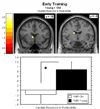The effects of aging on the neural basis of implicit associative learning in a probabilistic triplets learning task
- PMID: 21861675
- PMCID: PMC3629094
- DOI: 10.1162/jocn_a_00116
The effects of aging on the neural basis of implicit associative learning in a probabilistic triplets learning task
Abstract
Few studies have investigated how aging influences the neural basis of implicit associative learning, and available evidence is inconclusive. One emerging behavioral pattern is that age differences increase with practice, perhaps reflecting the involvement of different brain regions with training. Many studies report hippocampal involvement early on with learning becoming increasingly dependent on the caudate with practice. We tested the hypothesis that the contribution of these regions to learning changes with age because of differential age-related declines in the striatum and hippocampi. We assessed age-related differences in brain activation during implicit associative learning using the Triplets Learning Task. Over three event-related fMRI runs, 11 younger and 12 healthy older adults responded to only the third (target) stimulus in sequences of three stimuli ("triplets") by corresponding key press. Unbeknown to participants, the first stimulus' location predicted one target location for 80% of trials and another target location for 20% of trials. Both age groups learned associative regularities but differences in favor of the younger adults emerged with practice. The neural basis of learning (response to predictability) was examined by identifying regions that showed a greater response to triplets that occurred more frequently. Both age groups recruited the hippocampus early, but with training, the younger adults recruited their caudate whereas the older adults continued to rely on their hippocampus. This pattern enables older adults to maintain near-young levels of performance early in training, but not later, and adds to evidence that implicit associative learning is supported by different brain networks in younger and older adults.
Figures




Similar articles
-
Age group differences in learning-related activity reflect task stage, not learning stage.Behav Brain Res. 2022 Jan 7;416:113570. doi: 10.1016/j.bbr.2021.113570. Epub 2021 Sep 7. Behav Brain Res. 2022. PMID: 34499941 Free PMC article.
-
Age differences in implicit learning of probabilistic unstructured sequences.J Gerontol B Psychol Sci Soc Sci. 2011 Jan;66(1):32-8. doi: 10.1093/geronb/gbq066. Epub 2010 Oct 25. J Gerontol B Psychol Sci Soc Sci. 2011. PMID: 20974705 Free PMC article.
-
Implicit associative learning relates to basal ganglia gray matter microstructure in young and older adults.Behav Brain Res. 2021 Jan 15;397:112950. doi: 10.1016/j.bbr.2020.112950. Epub 2020 Oct 2. Behav Brain Res. 2021. PMID: 33017642 Free PMC article.
-
Does a simultaneous memory load affect older and younger adults' implicit associative learning?Neuropsychol Dev Cogn B Aging Neuropsychol Cogn. 2014;21(1):52-67. doi: 10.1080/13825585.2013.782998. Epub 2013 Apr 15. Neuropsychol Dev Cogn B Aging Neuropsychol Cogn. 2014. PMID: 23581975 Free PMC article.
-
Event simultaneity does not eliminate age deficits in implicit probabilistic sequence learning.Int J Aging Hum Dev. 2014;79(3):211-23. doi: 10.2190/AG.79.3.b. Int J Aging Hum Dev. 2014. PMID: 25622473 Free PMC article.
Cited by
-
White matter microstructural correlates of associative learning in the oldest-old.Cogn Affect Behav Neurosci. 2023 Feb;23(1):114-124. doi: 10.3758/s13415-022-01035-7. Epub 2022 Sep 26. Cogn Affect Behav Neurosci. 2023. PMID: 36163584 Free PMC article.
-
Task-related functional connectivity of the caudate mediates the association between trait mindfulness and implicit learning in older adults.Cogn Affect Behav Neurosci. 2016 Aug;16(4):736-53. doi: 10.3758/s13415-016-0427-2. Cogn Affect Behav Neurosci. 2016. PMID: 27121302 Free PMC article.
-
Dispositional mindfulness is associated with reduced implicit learning.Conscious Cogn. 2014 Aug;28:141-50. doi: 10.1016/j.concog.2014.07.002. Epub 2014 Jul 25. Conscious Cogn. 2014. PMID: 25062120 Free PMC article.
-
A systematic review of type 2 diabetes mellitus and hypertension in imaging studies of cognitive aging: time to establish new norms.Front Aging Neurosci. 2014 Jul 8;6:148. doi: 10.3389/fnagi.2014.00148. eCollection 2014. Front Aging Neurosci. 2014. PMID: 25071557 Free PMC article. Review.
-
Aging and the statistical learning of grammatical form classes.Psychol Aging. 2016 Aug;31(5):481-7. doi: 10.1037/pag0000110. Epub 2016 Jun 13. Psychol Aging. 2016. PMID: 27294711 Free PMC article.
References
-
- Aizenstein HJ, Butters MA, Clark KA, Figurski JL, Andrew Stenger V, Nebes RD, et al. Prefrontal and striatal activation in elderly subjects during concurrent implicit and explicit sequence learning. Neurobiol Aging. 2006;27:741–751. - PubMed
-
- Bennett IJ, Howard JH, Jr, Howard DV. Age-related differences in implicit learning of subtle third-order sequential structure. J Gerontol B Psychol Sci Soc Sci. 2007;62:P98–P103. - PubMed
Publication types
MeSH terms
Grants and funding
LinkOut - more resources
Full Text Sources
Medical

